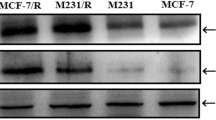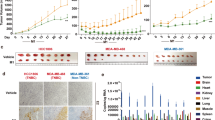Abstract
To evaluate resistance that develops in cancer cells during treatment with adenoviral vectors expressing proapoptotic genes, we repeatedly treated the human colon cancer cell line DLD1 with adenoviral vectors expressing the human Bax gene and the human tumor necrosis factor-related apoptosis-inducing ligand (TRAIL) gene. DLD1 cells resistant to the Bax- or TRAIL-expressing adenoviral vectors were then selected and designated as DLD1/Bax-R or DLD1/TRAIL-R cells, respectively. Further study showed that resistance in DLD1/Bax-R cells was caused by resistance to adenoviral infection, which can be overcome by dose escalation of the adenoviral vectors. However, resistance in DLD1/TRAIL-R cells was caused by resistance to the TRAIL gene. Therefore, different mechanisms are involved in the development of resistance during adenovirus-mediated proapoptotic gene therapy. A survey of molecules involved in TRAIL- or Bax-mediated apoptotic pathways showed no significant change in expression of death receptors, death decoy receptors; FLIP; Bcl-2; Bcl-xS; Bax; Bak; XIAP or caspase-2, -7, -8, or -9 in either DLD1/Bax-R or DLD1/TRAIL-R cells. Bcl-xL expression detected in both mRNA and protein level assays was three times higher in DLD1/TRAIL-R cells than in parental or DLD1/Bax-R cells. However, transfection of DLD1 cells with the Bcl-xL gene showed that overexpression of Bcl-xL is not sufficient for the resistance. Moreover, DLD1/Bax-R cells were sensitive to adenoviral vectors that expressed the TRAIL gene, but resistant to adenoviral vectors that expressed the Bak gene. In contrast, DLD1/TRAIL-R cells were sensitive to adenoviral vectors that expressed either Bax or Bak gene. Thus, alternative application of adenoviral vectors that expressed proapoptotic genes in different pathways or different cell killing models may delay or prevent development of resistance in adenovirus-mediated proapoptotic gene therapy.
This is a preview of subscription content, access via your institution
Access options
Subscribe to this journal
Receive 12 print issues and online access
$259.00 per year
only $21.58 per issue
Buy this article
- Purchase on Springer Link
- Instant access to full article PDF
Prices may be subject to local taxes which are calculated during checkout






Similar content being viewed by others
References
Kagawa S et al. Antitumor effect of adenovirus-mediated Bax gene transfer on p53-sensitive and p53-resistant cancer lines Cancer Res 2000 60: 1157–1161
Gu J et al. Tumor-specific transgene expression from the human telomerase reverse transcriptase promoter enables targeting of the therapeutic effects of the Bax gene to cancers Cancer Res 2000 60: 5359–5364
Li X et al. Adenovirus-mediated Bax overexpression for the induction of therapeutic apoptosis in prostate cancer Cancer Res 2001 61: 186–191
Tai YT, Strobel T, Kufe D, Cannistra SA . In vivo cytotoxicity of ovarian cancer cells through tumor-selective expression of the BAX gene Cancer Res 1999 59: 2121–2126
Kagawa S et al. Antitumor activity and bystander effects of the tumor necrosis factor-related apoptosis-inducing ligand (TRAIL) gene Cancer Res 2001 61: 3330–3338
Griffith TS et al. Adenoviral-mediated transfer of the TNF-related apoptosis-inducing ligand/Apo-2 ligand gene induces tumor cell apoptosis J Immunol 2000 165: 2886–2894
Jurgensmeier JM et al. Bax directly induces release of cytochrome c from isolated mitochondria Proc Natl Acad Sci USA 1998 95: 4997–5002
Pastorino JG et al. The overexpression of Bax produces cell death upon induction of the mitochondrial permeability transition J Biol Chem 1998 273: 7770–7775
Liu X et al. Induction of apoptotic program in cell-free extracts: requirement for dATP and cytochrome c Cell 1996 86: 147–157
Kluck RM, Bossy-Wetzel E, Green DR, Newmeyer DD . The release of cytochrome c from mitochondria: a primary site for Bcl-2 regulation of apoptosis Science 1997 275: 1132–1136
Oltvai ZN, Milliman CL, Korsmeyer SJ . Bcl-2 heterodimerizes in vivo with a conserved homolog, Bax, that accelerates programmed cell death Cell 1993 74: 609–619
Pan G et al. The receptor for the cytotoxic ligand TRAIL Science 1991 276: 111–113
Walczak H et al. TRAIL-R2: a novel apoptosis-mediating receptor for TRAIL EMBO J 1997 16: 5386–5397
Eggert A et al. Resistance to tumor necrosis factor-related apoptosis-inducing ligand (TRAIL)-induced apoptosis in neuroblastoma cells correlates with a loss of caspase-8 expression Cancer Res 2001 61: 1314–1319
Zhang XD et al. Mechanisms of resistance of normal cells to TRAIL induced apoptosis vary between different cell types FEBS Lett 2000 482: 193–199
Zhang XD et al. Tumor necrosis factor-related apoptosis-inducing ligand-induced apoptosis of human melanoma is regulated by smac/DIABLO release from mitochondria Cancer Res 2001 61: 7339–7348
Pan G et al. An antagonist decoy receptor and a death domain-containing receptor for TRAIL Science 1997 277: 815–818
Sheridan JP et al. Control of TRAIL-induced apoptosis by a family of signaling and decoy receptors Science 1997 277: 818–821
Degli-Esposti MA et al. The novel receptor TRAIL-R4 induces NF-kappaB and protects against TRAIL-mediated apoptosis, yet retains an incomplete death domain Immunity 1997 7: 813–820
Emery JG et al. Osteoprotegerin is a receptor for the cytotoxic ligand TRAIL J Biol Chem 1998 273: 14363–14367
Favrot M, Coll JL, Louis N, Negoescu A . Cell death and cancer: replacement of apoptotic genes and inactivation of death suppressor genes in therapy Gene Therapy 1998 5: 728–739
Kagawa S et al. A binary adenoviral vector for expressing high levels of the proapoptotic gene bax Gene Therapy 2000 7: 75–79
Bergelson JM et al. Isolation of a common receptor for Coxsackie B viruses and adenoviruses 2 and 5 Science 1997 275: 1320–1323
Davison E et al. Integrin alpha5beta1-mediated adenovirus infection is enhanced by the integrin-activating antibody TS2/16 J Virol 1997 71: 6204–6207
Goldman MJ, Wilson JM . Expression of alpha v beta 5 integrin is necessary for efficient adenovirus-mediated gene transfer in the human airway J Virol 1995 69: 5951–5958
Pearson AS et al. Factors limiting adenovirus-mediated gene transfer into human lung and pancreatic cancer cell lines Clin Cancer Res 1999 5: 4208–4213
Wickham TJ, Mathias P, Cheresh DA, Nemerow GR . Integrins alpha v beta 3 and alpha v beta 5 promote adenovirus internalization but not virus attachment Cell 1993 73: 309–319
Wickham TJ, Roelvink PW, Brough DE, Kovesdi I . Adenovirus targeted to heparan-containing receptors increases its gene delivery efficiency to multiple cell types Nature Biotech 1996 14: 1570–1573
Dmitriev I et al. An adenovirus vector with genetically modified fibers demonstrates expanded tropism via utilization of a coxsackievirus and adenovirus receptor-independent cell entry mechanism J Virol 1998 72: 9706–9713
Wickham TJ, Carrion ME, Kovesdi I . Targeting of adenovirus penton base to new receptors through replacement of its RGD motif with other receptor-specific peptide motifs Gene Therapy 1995 2: 750–756
Hinz S et al. Bcl-XL protects pancreatic adenocarcinoma cells against CD95- and TRAIL-receptor-mediated apoptosis Oncogene 2000 19: 5477–5486
Walczak H, Bouchon A, Stahl H, Krammer PH . Tumor necrosis factor-related apoptosis-inducing ligand retains its apoptosis-inducing capacity on Bcl-2- or Bcl-xL-overexpressing chemotherapy-resistant tumor cells Cancer Res 2000 60: 3051–3057
Fang B, Ji L, Bouvet M, Roth JA . Evaluation of GAL4/TATA in vivo. Induction of transgene expression by adenovirally mediated gene codelivery J Biol Chem 1998 273: 4972–4975
Koch P et al. Augmenting transgene expression from carcinoembryonic antigen (CEA) promoter via a GAL4 gene regulatory system Mol Ther J Am Soc Gene Ther 2001 3: 278–283
Fang B, Xu B, Koch P, Roth JA . Intercellular trafficking of VP22-GFP fusion proteins is not observed in cultured mammalian cells Gene Therapy 1998 5: 1420–1424
Acknowledgements
This work was supported in part by a research project grant from the American Cancer Society (RPG-00-274-01-MGO to BF); an Institutional Start-Up Fund (to BF); a grant from the WM Keck Center for Cancer Gene Therapy, The University of Texas MD Anderson Cancer Center (BF); an NIH project grant (P01 CA78778-01A1, to JAR); and an NIH Core Grant (CA16672). JG is an MD Anderson Cancer Center Odyssey Program Fellow supported by the Kimberly-Clark Endowment for New and Innovative Research. We thank Allan Prejusa and Trupti Mehta for adenovirus propagation and quality control and Kate O Suilleabhain for editorial review.
Author information
Authors and Affiliations
Rights and permissions
About this article
Cite this article
Zhang, L., Gu, J., Lin, T. et al. Mechanisms involved in development of resistance to adenovirus-mediated proapoptotic gene therapy in DLD1 human colon cancer cell line. Gene Ther 9, 1262–1270 (2002). https://doi.org/10.1038/sj.gt.3301797
Received:
Accepted:
Published:
Issue Date:
DOI: https://doi.org/10.1038/sj.gt.3301797
Keywords
This article is cited by
-
TRAIL-based gene delivery and therapeutic strategies
Acta Pharmacologica Sinica (2019)
-
Oxidative stress in NSC-741909-induced apoptosis of cancer cells
Journal of Translational Medicine (2010)
-
Death receptor-4 (DR4) expression is regulated by transcription factor NF-κB in response to etoposide treatment
Apoptosis (2008)
-
Doxorubicin enhances TRAIL-induced cell death via ceramide-enriched membrane platforms
Apoptosis (2007)
-
Specific resistance upon lentiviral TRAIL transfer by intracellular retention of TRAIL receptors
Cell Death & Differentiation (2006)



